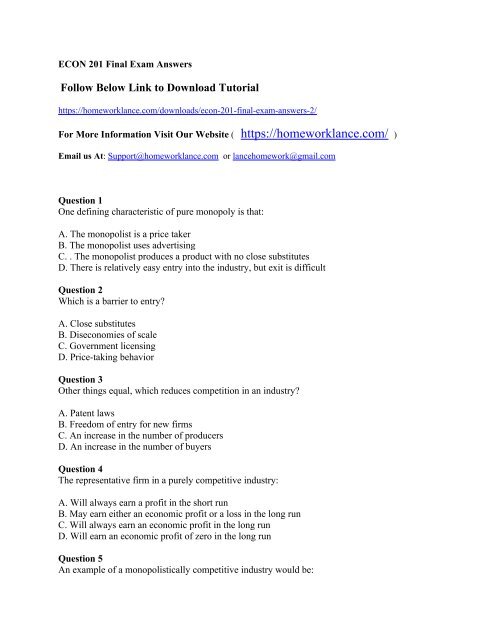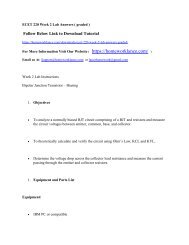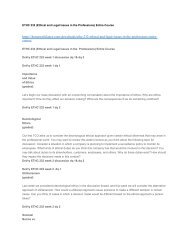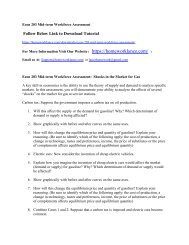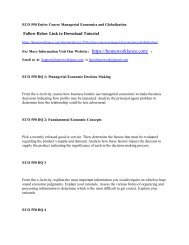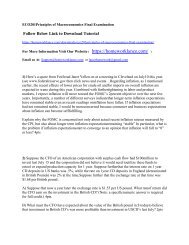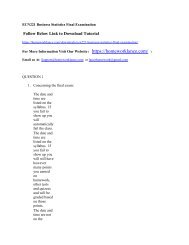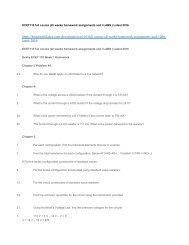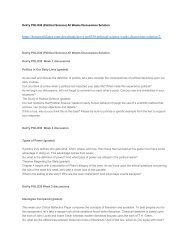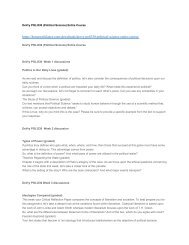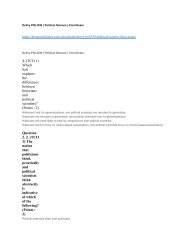ECON 201 Final Exam Answers
Create successful ePaper yourself
Turn your PDF publications into a flip-book with our unique Google optimized e-Paper software.
<strong>ECON</strong> <strong>201</strong> <strong>Final</strong> <strong>Exam</strong> <strong>Answers</strong><br />
Follow Below Link to Download Tutorial<br />
https://homeworklance.com/downloads/econ-<strong>201</strong>-final-exam-answers-2/<br />
For More Information Visit Our Website ( https://homeworklance.com/ )<br />
Email us At: Support@homeworklance.com or lancehomework@gmail.com<br />
Question 1<br />
One defining characteristic of pure monopoly is that:<br />
A. The monopolist is a price taker<br />
B. The monopolist uses advertising<br />
C. . The monopolist produces a product with no close substitutes<br />
D. There is relatively easy entry into the industry, but exit is difficult<br />
Question 2<br />
Which is a barrier to entry?<br />
A. Close substitutes<br />
B. Diseconomies of scale<br />
C. Government licensing<br />
D. Price-taking behavior<br />
Question 3<br />
Other things equal, which reduces competition in an industry?<br />
A. Patent laws<br />
B. Freedom of entry for new firms<br />
C. An increase in the number of producers<br />
D. An increase in the number of buyers<br />
Question 4<br />
The representative firm in a purely competitive industry:<br />
A. Will always earn a profit in the short run<br />
B. May earn either an economic profit or a loss in the long run<br />
C. Will always earn an economic profit in the long run<br />
D. Will earn an economic profit of zero in the long run<br />
Question 5<br />
An example of a monopolistically competitive industry would be:
A. Steel<br />
B. Soybeans<br />
C. Electricity<br />
D. Retail clothing<br />
Question 6<br />
Firms in an industry will not earn long-run economic profits if:<br />
A. Fixed costs are zero<br />
B. The number of firms in the industry is fixed<br />
C. There is free entry and exit of firms in the industry<br />
D. Production costs for a given level of output are minimized<br />
Question 7<br />
Marginal product is:<br />
A. the increase in total output attributable to the employment of one more worker.<br />
B. the increase in total revenue attributable to the employment of one more worker.<br />
C. the increase in total cost attributable to the employment of one more worker.<br />
D. total product divided by the number of workers employed.<br />
Question 8<br />
The law of diminishing returns indicates that:<br />
A. as extra units of a variable resource are added to a fixed resource, marginal product will<br />
decline beyond some point.<br />
B. because of economies and diseconomies of scale a competitive firm’s long-run average total<br />
cost curve will be U-shaped.<br />
C. the demand for goods produced by purely competitive industries is down sloping.<br />
D. beyond some point the extra utility derived from additional units of a product will yield the<br />
consumer smaller and smaller extra amounts of satisfaction.<br />
Question 9<br />
Which of the following is most likely to be a variable cost?<br />
A. fuel and power payments<br />
B. interest on business loans<br />
C. rental payments on IBM equipment<br />
D. real estate taxes<br />
Question 10<br />
If average total cost is declining, then:
A. marginal cost must be greater than average total cost.<br />
B. the average fixed cost curve must lie above the average variable cost curve.<br />
C. marginal cost must be less than average total cost.<br />
D. total cost must also be declining.<br />
Question 11<br />
The selling of stock is debt financing for a corporation.<br />
o True<br />
o False<br />
Question 12<br />
Average fixed costs diminish continuously as output increases.<br />
o True<br />
o False<br />
Question 13<br />
Patents and copyrights were established by the government to reduce oligopoly and monopoly<br />
power.<br />
o True<br />
o False<br />
Question 14<br />
Prices in oligopolistic industries are predicted to fluctuate widely and frequently compared to<br />
other market structures.<br />
• True<br />
• False<br />
Question 15<br />
The positive view of advertising suggests that it contributes to economic efficiency in the<br />
economy.<br />
o True<br />
o False<br />
Question 16<br />
Price fixing is illegal under Section 1 of the Sherman Act.
o True<br />
o False<br />
Question 17<br />
Rent-seeking behavior refers to activities designed to transfer income or wealth to a particular<br />
firm or resource supplier at someone else’s or society’s expense.<br />
o True<br />
o False<br />
Question 18<br />
A purely competitive firm is a price maker, but a monopolist is a price taker.<br />
o True<br />
o False<br />
Question 19<br />
(Exhibit: Short-Run Costs) At the given price, the most profitable level of output occurs at<br />
quantity:<br />
A. N<br />
B. P<br />
C. S<br />
D. T<br />
Question 20<br />
(Exhibit: Short-Run Costs) If the price declines, the minimum quantity of output supplied in the<br />
short run is quantity:<br />
A. O.<br />
B. Q.<br />
C. R.<br />
D. S.<br />
Question 21<br />
(Exhibit: Short-Run Costs) If the price declines, production will continue in the short run, even<br />
though the firm incurs a loss, between quantities:
A. and Q.<br />
B. Q and R.<br />
C. R and S.<br />
D. S and T.<br />
Question 22<br />
(Exhibit: Short-Run Costs) This firm’s supply curve begins at quantity:<br />
A. Q.<br />
B. R.<br />
C. S.<br />
D. T.<br />
Question 23<br />
(Exhibit: Profit Maximization in Monopolistic Competition) A firm in monopolistic competition<br />
will maximize profits by producing the level of output where:<br />
a. P = MC<br />
b. MR = MC<br />
c. P = MR<br />
d. price minus ATC (i.e., economic profit per unit) is the largest.<br />
Question 24<br />
(Exhibit: Profit Maximization in Monopolistic Competition) In the short run, a firm in<br />
monopolistic competition may experience economic profits as shown in Panel (a) as the distance:<br />
a. PS.<br />
b. PS times the quantity 0M.<br />
c. PS times the quantity Q.<br />
d. PT times the quantity Q.<br />
Question 25<br />
(Exhibit: Profit Maximization in Monopolistic Competition) If other firms see economic profits<br />
in the industry, they will enter it, and the demand curve for firms already in the industry will shift<br />
to the ________ ; in the long run, this will result in economic profit _______ and price _______ .
a. right; = 0; = ATC; = minimum ATC<br />
b. right; > 0; > ATC<br />
c. left; < 0; < ATC d. left; = 0; = ATC; > minimum ATC<br />
Question 26<br />
(Exhibit: Profit Maximization in Monopolistic Competition) In monopolistic competition, longrun<br />
equilibrium is characterized by:<br />
a. P > MR.<br />
b. P < MR. c. P = MR. d. profit maximization, which occurs where P = MR = MC. Question 27<br />
(Exhibit: Profit Maximization in Monopolistic Competition) In Panel (a), if the firm raises its<br />
price above P, it will:<br />
a. lose all its customers.<br />
b. still have some customers.<br />
c. not lose any customers.<br />
d. have none of the above occur.<br />
Question 28<br />
(Exhibit: Profit Maximization in Monopolistic Competition) In determining the price in<br />
monopolistic competition:<br />
a. the price to the firm is given by supply and demand for the industry.<br />
b. the firm is a price taker.<br />
c. the firm applies the marginal decision rule.<br />
d. A and B are true.<br />
Question 29<br />
Which of the following is (are) most likely to be produced under conditions resembling perfect<br />
competition – automobiles, beer, corn, diamonds, and eggs. Defend your answer in economic<br />
terms.


